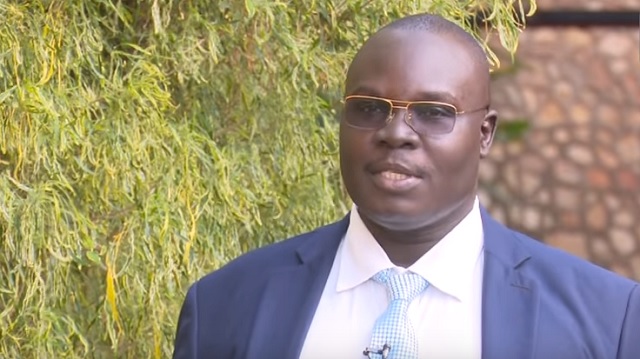
Kampala, Uganda | AGNES E NANTABA | Sydney Asubo is the Executive Director of Financial Intelligence Authority (FIA). He spoke to the Independent’s Agnes E Nantaba about the status of money laundering in Uganda and efforts to combat it.
What encompasses your management style?
My philosophy has essentially remained the same over the years. While the institution has expanded, the staff numbers we have are not where we want to be. We are even doing a re-evaluation of the staff numbers that we need to address the challenge because the task is bigger than we thought. Three years back, we didn’t have much studies like we do today and with our experience, we now know the magnitude of the problem. We have plans to recruit 15 additional staff because we were provided with the funds in areas of operational analysis, international relations, inspections and compliance. My strength as a team leader lies in team work and lead by example. For instance, with regards to time management, I am an adept. I am the chief custodian of the policies of the organization.
We interact easily and the gap between the leadership and the staff is narrow so they can reach me easily and vice versa. We have also built the systems such that certain things can flow automatically even without my physical presence.
What is your assessment of the status of money laundering in Uganda?
When a law is enacted, it means a problem has been identified and the law comes in to that particular mischief. In this case, it’s the crime of money laundering and terrorism financing.
So the question then is that ‘is it as big as we thought? And in our view, it is actually worse than we thought. We have actually done a national risk assessment of the problem, presented in the report ‘Anti-money laundering/combating of terrorism risk assessment’ and the report was approved by cabinet last year and will be released to the public in three weeks’ time.
From the national risk assessment, we were able to track the problem areas. For instance, the main channel that launderers use is the banking industry although there are also other money remittances like the forex, non-regulated or under-regulated businesses like the real estate sector and this is a global trend not unique to Uganda. In Uganda, the real estate is particularly problematic because up to 80 percent of land is not titled, it’s also possible to acquire a property and one doesn’t need to change ownership because there is no obligation to do that. What is involved is only a sales agreement and therefore records still show somebody else as the owner, and therefore don’t have proof that this building or land belongs to this individual. But also, the dealers in precious stones and metals including gold and diamonds is a big business because the amounts that flow through this business are staggering and some of these problems arise from neighboring countries, such as the Eastern Democratic Republic of Congo.
One of the long term solutions is to reduce the amount of cash in the economy to use alternative means of payment other than cash because it’s very easy to transact with cash without leaving any traces which is not the same with electronic means. Government has agreed to reduce money within the next 10 to 15 years. Currently, the law requires that anyone who’s moving out of the country with Shs 30 million or the equivalent should be declared, but with the porous borders, it is hard to be implemented. We also propose to reduce the number of informal business because they increase opportunities for money laundering. Government should come up with policies to incentivize the formalization of business to move gradually to formal business structures. There are also short term solutions like enhancing training, legal gaps, which we propose to be amended to meet both the international and domestic requirements.
Banks, for instance, should be more vigilant in knowing their customers, train their front line staff on the possible signs of suspicious transactions and increase bank’s awareness on the means people use to launder money. But there are also some short term measures like enhancing training and skills of the people, amendment of the legal gaps.
FIA’s main objective is fighting money laundering and financial fraud / crimes as established by the Anti – Money Laundering Act 2013. To what extent have your realized this objective?
We have achieved 80 percent of our objective in the first three years. Using a marking scheme, as a new organization, the priority has been setting up an organization to exist with in-house settings and that has been done. The core mandate of FIA is to receive suspicious transactions, analyze that information, transform into intelligence and disseminate to law enforcement and which we can ably do. We are now a self-accounting vote and we are able to budget, plan and execute. However the key achievement was getting Uganda off the Financial Action Task Force (FATF) watch list since we currently possess the requisite legal and institutional framework to fight money laundering. The legal framework is in line with international standards as well being in good books with Eastern and Southern Africa Anti-Money Laundering Group (ESAAMLG) and this has been a result of assessment that was done twice.
Obviously, the work schedule in the first three years is not the same like in the next three years and therefore we have developed a strategic plan 2016-2020 and we intend to do a midterm review of the same. For instance, in terms of public awareness, we have not done well and so we want to increase awareness of the law both in terms of those who are supposed to comply with the law, those who are supposed to implement the law and those who are supposed to know about the law. And in liaison with the police, we need to increase the number of investigations and court cases related to money laundering and anti-terrorism financing.
The purpose of Cash Transaction Reports (CTRs) is to detect money laundered at its entry into the financial system but it has been reported that FIA has not created awareness about the issuance of the reports? What explains this?
That is not true. The first things we did was to develop the forms for large cash transactions just a month after we had been created. We went ahead to issue a notice informing accountable persons or reporting entities that the law was in place and that they have obligations to report large cash transactions of Shs20million and above done over banks whether debit or credit. So the banks were issued and they have been compliant so that was dealt with.
The bureaucracy involved in analyzing CTRs and prosecution of money laundering cases provides an avenue for evasion by money launderers. What are your close-gap measures in this?
The law states the reports come to FIA, we analyze and disseminate them. The problem has been that the process or system is manual but this shall cease to happen as we have acquired the goAML system. The software is a solution that automates Anti-Money Laundering reporting requirements. It’s going to be operational in June and with it, analysis will be made faster.
Uganda adopted the threshold provided by the Financial Action Task Force of $10000 – $15000 to reduce the inconvenience in the day to day businesses operations. What impact has this created?
There has been a misconception in the reporting mechanism and processes as people think that they are the ones to report to FIA yet it is the role of the bank to report to FIA and that’s where their obligation stops. FIA then takes on from after picking out what’s of interest to us and write back to them requesting for more information about a specific transaction. If they have it, they send and if they don’t, they search for the source of the money. If we need more information on the report, the banks are obliged to send it in accordance with the law. In an attempt to do so, most banks now have a paragraph to indicate source of the money.
The Money Laundering and Terrorist Financing National Risk Assessment report that was passed by cabinet indicates that the country suffers from a low money laundering combating ability. Where does the challenge lie?
First of all, we assessed the level of risk of the challenge. For those that are high risk, we explore the reasons for instance real estate is a high risk area because there is no regulator, 80 percent of the land is not titled and it is not compulsory to transfer ownership in Uganda. The other challenge is lack of capacity or low staff numbers, lack of awareness for instance money laundering is not one of the core crimes where training is offered at Police Training School so we propose to make money laundering one of the core crimes where CID offers are trained.
The illegal operations of forex bureaus also pose a threat for instance there are 300 licensed or legal forex bureaus but those that are operating illegally are more and this stands as another way that people use to launder money. We have had engagements with Uganda Forex Bureaus and Money Remitters Association (UFBMRA) to find ways of improving their awareness of the law and passing on to its members.
What is your projection of FIA in the next few years?
Of the things we set out to do in the first three years, we have achieved 80 percent but in terms of combatting money laundering, we are still at the infancy because within three years, we cannot successfully have fought the crime. The future lies in making FIA effective and working very well with sister organizations so that the intelligence we produce leads to successful investigations, successful prosecution, and successful recovery of the illicit monies.
 The Independent Uganda: You get the Truth we Pay the Price
The Independent Uganda: You get the Truth we Pay the Price



